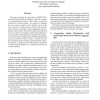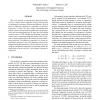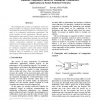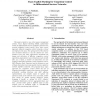SIGMETRICS
2010
ACM
14 years 5 months ago
2010
ACM
: The packet is the fundamental unit of transportation in modern communication networks such as the Internet. Physical layer scheduling decisions are made at the level of packets, ...
INFOCOM
2002
IEEE
14 years 5 months ago
2002
IEEE
– Typically, NACK-based congestion control is dismissed as being not viable due to the common notion that “open-loop” congestion control is simply “difficult.” Emerging r...
ICNP
2002
IEEE
14 years 5 months ago
2002
IEEE
This paper describes the main ideas of DRMTP (Distributed Real-time Multicast Transport Protocol), an adaptive application-level protocol which allows cooperative multicast of rea...
ICNP
2002
IEEE
14 years 5 months ago
2002
IEEE
This work presents a comprehensive theoretical framework for window-based congestion control protocols that are designed to converge to fairness and efficiency. We first derive ...
DANCE
2002
IEEE
14 years 5 months ago
2002
IEEE
Active Congestion Control (ACC) applies active networking to feedback congestion control an a high bandwidth-delay product network, shortening the feedback loop by filtering traf...
SAINT
2003
IEEE
14 years 6 months ago
2003
IEEE
In recent years, AQM (Active Queue Management) mechanisms, which support the end-to-end congestion control mechanism of TCP by performing congestion control at a router, have been...
ISCC
2003
IEEE
14 years 6 months ago
2003
IEEE
We investigate the problem of congestion control for multicast traffic over datagram packet switched networks and present an end-to-end solution to it. The focus of our study is o...
ISCC
2003
IEEE
14 years 6 months ago
2003
IEEE
This paper presents a new active queue management scheme, Fuzzy Explicit Marking (FEM), implemented within the differentiated services (Diff-Serv) framework to provide congestion ...
INFOCOM
2003
IEEE
14 years 6 months ago
2003
IEEE
— A significant impediment to deployment of multicast services is the daunting technical complexity of developing, testing and validating congestion control protocols fit for w...
INFOCOM
2003
IEEE
14 years 6 months ago
2003
IEEE
— Efficient use of network resources has long been an important problem for large-scale network operators. To this end, several recent research efforts have proposed automated m...




